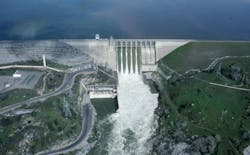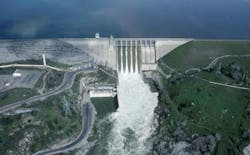Dams, not diesel, now in climate change crosshairs
Goodness me! Seems we might have been too fast clamping down on diesel as one of primary culprits behind global warming. Instead, a new and far more dastardly global warming perpetrator may be at work, going about its fiendish warming ways silently and sneakily.
That culprit is … wait for it … WATER; specifically water trapped by man-made dams and funneled into man-made reservoirs.This is the initial conclusion of research by Bridget Deemer, a doctoral student at Washington State University-Vancouver.
In a story published on the WSU website and now getting wide distribution (I first stumbled on it within the electronic folds of the Economic Times of India myself) Deemer said she measured dissolved gases in the water column of Lacamas Lake in Clark County and found that methane emissions – a substance 25 times more effective than carbon dioxide at trapping heat in the atmosphere; the so-called “greenhouse effect” that scientists in the global warming camp say causes global temperatures to rise – jumped 20-fold when the water level was drawn down.
A fellow WSU-Vancouver student, Maria Glavin, went on to sample bubbles rising from the lake mud and measured a 36-fold increase in methane during a “draw down,” which is when water is taken out of the reservoir by the local municipality to supply fluid for drinking, washing clothes, fire suppression, etc.
Deemer went on to say that while dams and the water behind them cover only a small portion of the earth's surface, they harbor “biological activity” that can produce large amounts of greenhouse gases. And this ain’t a small problem in her eyes, either, as there are also some 80,000 dams in the U.S. alone, according to the U.S. Army Corps of Engineers National Inventory of Dams.“Reservoirs have typically been looked at as a green energy source,” Deemer told WSU science writer Eric Sorenson. “But their role in greenhouse gas emissions has been overlooked.”
OK, while it’s tempting to make snarky comments about Deemer’s findings (maybe the Environmental Protection Agency (EPA) should file suit against reservoir water bacteria to cease and desist from their heinous warming activity) she’s actually performed a very valuable service here.
I mean, if reservoir-bound bacteria potentially pose the biggest global warming threat, maybe it provides the basis for tempering a whole host of federal regulatory efforts.
Take the EPA’s Mercury Air Toxics Standards (MATS) scheduled to take effect in 2015, which propose some costly caps on power plant emissions in part to reduce the production of greenhouse gases (GHG).
The rule, now being hotly contested in court, could result in removing a lot of electrical generation capacity in the U.S. – meaning that many folks might end facing less access to things like air conditioning. Care to go without when the temperature is 100 degrees out? I didn’t think so.
Or how about the GHG rules for heavy trucks? Maybe the global warming threat posed by bacteria in reservoir water might convince the EPA to give OEMs more time to comply with them – might help reduce the cost impact on truckers, too, if manufacturers get a little more time to fine tune their technological solutions.
I’m just saying!


